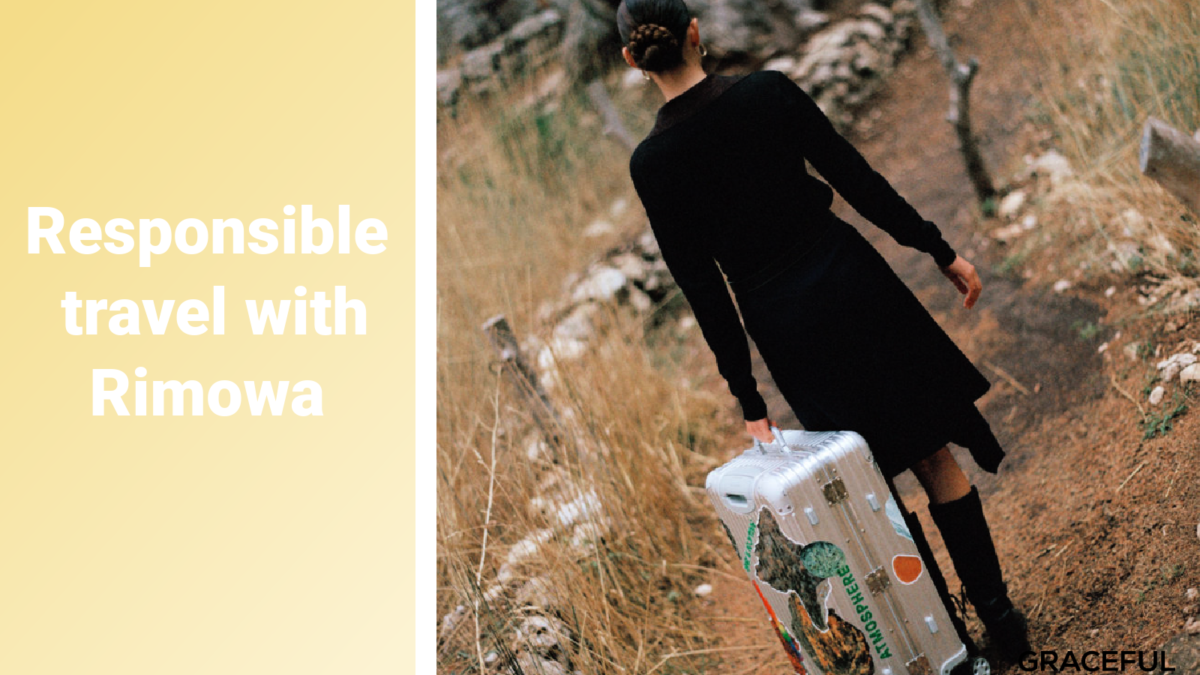How Using a Quality Suitcase (Rimowa) is the First Step to Responsible Travel
Updated on December 13th, 2022
Chances are that if you’re an avid traveler, you’ve heard the term “Responsible Travel” recently. It’s a trending topic and almost every airline, travel publication, or tourism service provider are talking about it. At first glance, this concept seems to be another buzzword to jump on the sustainability bandwagon.
However, the idea as a whole goes deeper than just all-inclusive packages to eco-villas or volunteering at wildlife reserves. It’s a concept that can be applied to all areas and types of travel, from where you travel and how you get there down to what suitcase you bring along with you on your trips.
What is Responsible Travel?
Since each trip has differing variables from where you’re going, the mode of transport taken, dietary restrictions, etc. It makes it difficult to pin down hard and fast rules for responsible travel. This is why when it comes to responsible travel it’s not about following a list of must-dos and don’ts, but rather about understanding the concept of responsible travel and applying it to your holidays and adventures how you see fit.
When we boil it down, responsible travel is the way that you make your decisions while preparing for your trips and during your travels. It is about considering the larger environmental and social impact that your choices have. Responsible travelers head out on their trips with a sense of awareness of this impact and implore a duty to create more positive impact than negative.
Be Aware of your Environmental Impact While Traveling
Lessening your environmental impact is a key pillar of responsible travel. This can be done by taking transport that creates less of an impact (i.e. trains over planes, or public transport over uber) or using high-quality travel items that you can continuously use each trip.
There are endless little ways to reduce your travel footprint while you’re exploring the world. Every responsible decision can add up to a huge reduction in environmental impact and pollution. Just think about it, if everyone decides to bring reusable toiletries rather than the typical single-use ones, that could save the world a lot of plastic pollution.
Be Aware of The Social Impact
One of the main aims of responsible travel is to create a sustainable positive impact among the local communities of the place we travel to. This can easily be achieved by making responsible decisions about where you spend your money while traveling.
By choosing to stay at locally-owned accommodations, eat at local restaurants, or buy your souvenirs from local artisans, you’re directly supporting the local community and making the tourism sector for the destination a little more sustainable.
A High-Quality Suitcase is the First Step for Responsible Travel
Before you even take off on your holiday or business trip, you can start to make responsible decisions. One of the first and most straightforward steps you can take is to invest in a quality suitcase.
Think about it, a suitcase is an item that comes with you on every trip and often gets treated the most harshly. From the wheels having to navigate all sorts of surfaces like cobblestone streets or how the baggage handlers at the airport toss it from here to there. It really takes a beating every time you travel. Needless to say, it needs to be a quality suitcase if it’s going to last more than a couple of trips.
While there are many suitcases on the market that are inexpensive they tend to fall apart– which is not fun when you’re mid-walk to the hotel and your luggage wheel pops off. More importantly, it’s not a responsible practice to buy a new suitcase every year. Suitcases aren’t easy to recycle, they use a lot of materials that have high pollution rates, and it’s not easy to make an eco-friendly, high-quality
Every time you buy a new suitcase, the old one most likely ends up in the landfill since they are notoriously hard to recycle. Since they’re mostly made from synthetic materials like polyester, they can take up to 200 years to decompose– meaning all of the suitcases you’ve ever bought and thrown away will be on the earth long after you’re gone– that’s a crazy thought.
Why Investing in a Rimowa Suitcase is Beneficial for the Planet
The most responsible thing we can do is to buy a suitcase that will last for the long haul. This is why opting for a high-quality suitcase is the first step to becoming a responsible traveler. Plus, in the end, it’ll save you some cash because you won’t have to replace it as often.
A Rimowa suitcase is a great choice, it ticks all the boxes in terms of responsibility. First and foremost they are made to last with high-quality materials that have been tried and tested against some pretty rough travel conditions. They’re crafted with care and the utmost attention to quality in their factories in Canada, Czech Republic, and Germany.
In many cases a Rimowa will outlast your need for it, when that happens it can easily be passed down to your kids or other loved ones– elongating its life even further. If you don’t want to pass it down, there’s a massive market for pre-loved items, and a Rimowa is a hot ticket for buying used– but before you put it up for sale, double check the going price. You’d be surprised, but sometimes Rimowa luggage appreciate in value.
While those are all responsible options, there’s really no need to get rid of a Rimowa as long as you’re still traveling, since the design of Rimowa has become a classic. While the color offering might change, the shape stays consistent, so you don’t feel as much pressure to update your luggage while you still have a perfectly good one.
Lastly, Rimowa has recently implemented a Lifetime Guarantee on any luggage from 2022 onward, as long as you’ve registered it upon purchase. This ensures that even if your luggage starts to break down five years from now, they’ll fix it for you, rather than having to toss it– a very responsible practice.
Other Responsible Travel Practices
Packing Responsibly
Using a Rimowa suitcase is just the first step in becoming a responsible traveler, what goes inside your luggage is the next step. There are many ways that you can pack responsibly– from packing less overall to what kind of toiletries you bring. It all has an effect on the overall impact. Some of the easiest ways to become a responsible packer are:
Glass or reusable toiletries rather than single-use plastics
Using mini single-use toiletries that are made of plastic is not responsible. This is because they’re directly adding to plastic pollution, which has become an epidemic in the world. Luckily there’s a quick fix for this.
You can use a refillable toiletry bottle, or instead of plastic toiletries purchased from a brand that makes their travel-sized toiletries with glass bottles– like the ones available in the Rimowa and Aesop Kōln collaboration.
Pack Less or Lighter
Packing less or lighter might not be the first thing you think of when you’re trying to lessen your impact while traveling, but the weight of our suitcase actually can make a difference. When Air New Zealand chief executive Greg Foran asked travelers to help them with their goal of becoming net zero by packing less, we learned that this was a serious way to reduce environmental impact.
“The heavier your luggage, the more fuel is required to get you to your destination, by leaving a few things at home, you’ll be helping us fly lighter, and reduce our carbon emissions,” Foran Said
“The heavier your luggage, the more fuel is required to get you to your destination, by leaving a few things at home, you’ll be helping us fly lighter, and reduce our carbon emissions,”
The weight of the plane directly impacts its fuel efficiency levels, so leaving a few items behind is an easy way to curb your impact.
Swap Silicone Bag for Plastic Baggie
When we are packing our carry-on liquids we often just throw them into a plastic ziplock bag and call it a day. Upon arrival, this plastic bag normally gets tossed or used till it rips. While it might not seem like a big deal, if every traveler repeats this on every trip they take, it quickly adds up to a lot of plastic waste. Instead, invest in a Silicone Ziplock style bag that you can continually reuse for years to come.
Another Key Responsible Travel Action: Choosing your location
Believe it or not, where you travel can also play into if you’re traveling responsibly or not. Some locations are automatically more responsible, like local destinations that don’t require plane travel or extensive driving.
However, if you’re itching for a place that’s not in your neck of the woods, picking a location that’s tourism sector has a focus on sustainability is key. You’ll be surprised to see how many incredible locations around the world ensure their tourists are responsible.
Sustainable Holiday Destinations
Iceland
The Nordic island country of fire and ice makes it extremely easy to indulge in responsible travel practices while visiting. From their pre-arrival courses that will educate you on how to be a sustainable tourist to how to be safe while in Iceland, their board of tourism has all the basics of responsible travel covered.
While you’re there you can rest assured that you’re not causing a large environmental impact since the country runs on nearly 100% renewable energies. Places like the Instagram famous blue lagoon are completely run on geothermal energy. Even if you’re planning to do the famous road trip around the entire island in 14 days, they have a wide network of electric vehicles and charging points.
Vilnius, Lithuania
If you’re looking for a place that’s responsible yet off the beaten path, Lithuania should be on your radar. The Eastern European country is not only gorgeous, but it also has some pretty impressive sustainability credentials. The capital city, Vilnius, was named Europe’s most green city in 2020– it’s one of 100 European cities to put forward a plan to become climate neutral by 2030.
While the city is green in the eco-aspect of the word, it’s also one of the greenest cities in Europe, in terms of green spaces available as well. You’ll forget you are in the country’s largest city with all the areas to sprawl out in the grass or go for tree-covered walks.
Vilnius is working on becoming a 15-minute city which means you can get all your necessities within 15 minutes of walking from anywhere in the city. This cuts back on unnecessary driving– and if you need to go further than walking distance, their wide network of sustainable mobility transport has you covered with their electric cars, scooters, and trains. Soon you’ll be able to travel all of Lithuania on their carbon-neutral railway that was approved this year.
Costa Rica
People are drawn to Costa Rica for the “Pura Vida” which means the pure life, speaking to the country’s innate lifestyle of slow, wellness-infused living. Making it one of the world’s best wellness destinations, but it’s also one of the best places to travel responsibly. The tropical country has had sustainable tourism as a major pillar within its economic plans since the 90s. In 1997 they created a certificate for tourism services to prove that they are doing business responsibly.
Plus, 99% of the time Costa Rica runs on renewable energy, the country even broke the world record for how long an entire country has run on renewables in a row at 300 consecutive days. It’s initiatives like this that earned Costa Rica the title of “Champion of the Earth” by the EU, and what makes it nearly impossible to travel irresponsibly in Costa Rica.
Bhutan
If you haven’t heard of Bhutan you’re not alone. The small kingdom is located nestled in the Himalayan mountains between India and China and only opened its doors to tourists in 1974. Bhutan is one of the only countries in the world that is entirely carbon neutral. In 2021 they used 3.8 million tons of CO2 emissions but sequestered 9.4million tons. However, this is what makes the country a responsible destination.
The country proudly values high-value tourism over high volumes of tourism. Every tourist is subject to a $200 per night sustainable development fee. This is how Bhutan ensures their country won’t be subject to over-tourism, while also paying for their social and sustainable developments, such as healthcare, education, re-skilling tourism workers, planting trees, and maintaining trails.
Conclusion
All in all, there are many ways to become a responsible traveler. Starting with the low-hanging fruit like investing in a high-quality suitcase like Rimowa makes it easy to start the domino effect of making more responsible travel decisions.
Remember that each and every choice you make has the opportunity to either create a positive or negative impact. When you head out on your next adventure, we hope that you choose the positive and that when you look down at your Rimowa it serves as a reminder to be aware of your actions.






